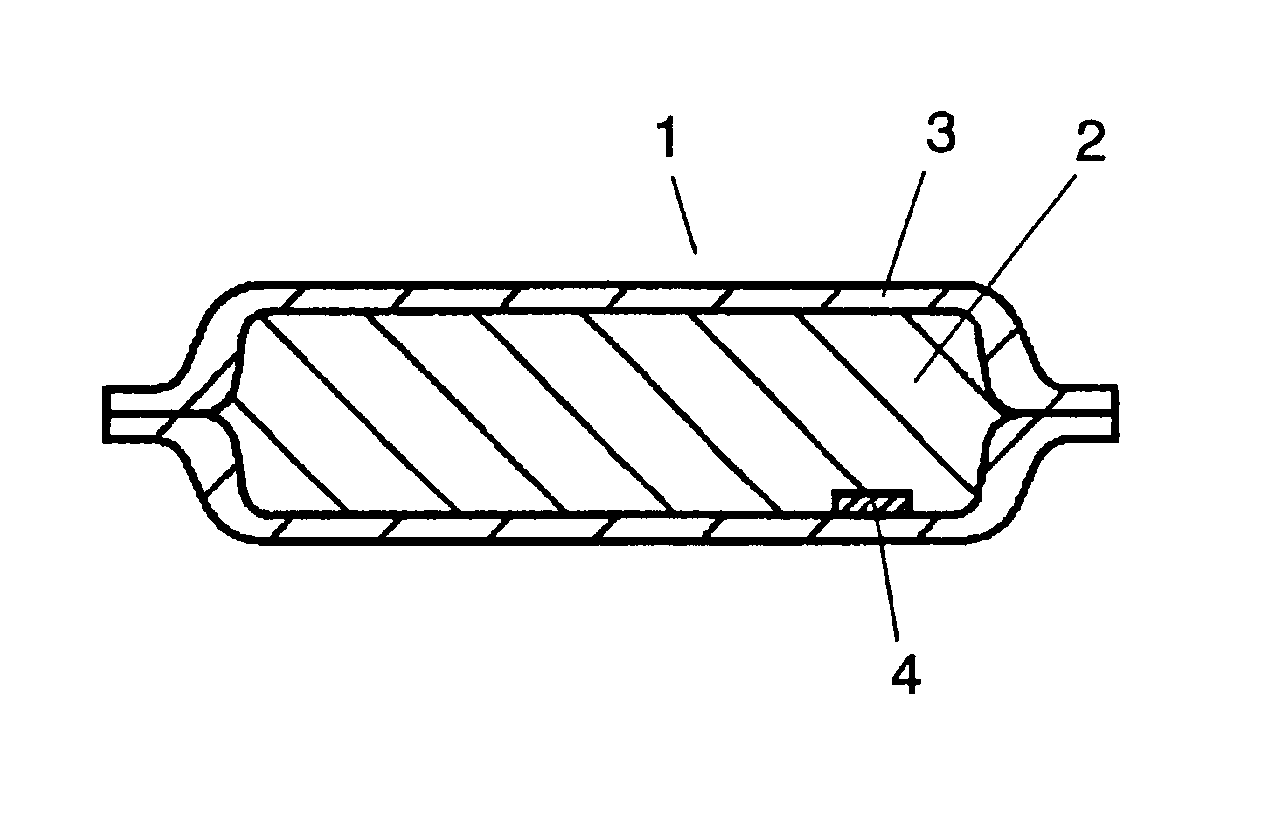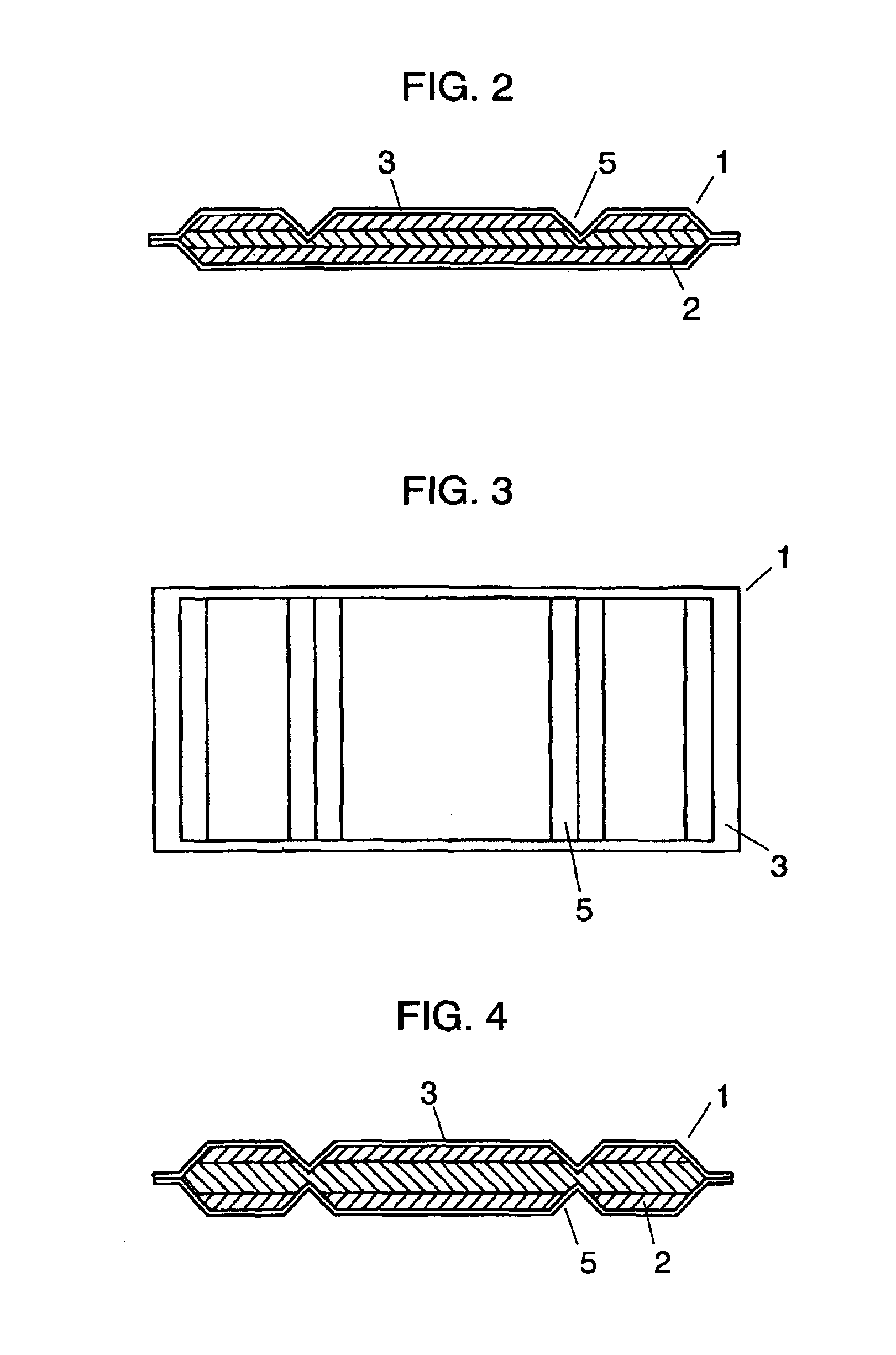Vacuum insulating material and device using the same
a technology of vacuum insulation and material, which is applied in the direction of lighting and heating equipment, household cooling equipment, packaging goods, etc., can solve the problems of inability to use prior art techniques, long time gives users uncomfortable feelings, and inability to meet user needs
- Summary
- Abstract
- Description
- Claims
- Application Information
AI Technical Summary
Benefits of technology
Problems solved by technology
Method used
Image
Examples
first exemplary embodiment
[0039]FIG. 1 shows a sectional view of a vacuum heat insulator in an exemplary embodiment of the present invention, wherein the vacuum heat insulator 1 comprises a core 2, an enveloping member 3, and an absorbent 4.
[0040]The enveloping member 3 comprises two kinds of laminated films.
[0041]One of the laminated films covering one face of the vacuum heat insulator has a four-layer structure comprising polyamide film (16 μm), aluminum foil (6 μm), polyethylene terephthalate film (12 μm), and high density polyethylene film (50 μm). The polyamide film constitutes an outermost layer acting as a surface protective layer, and the high-density polyethylene layer is for a purpose of heat seal.
[0042]Another face consists of a laminated film comprising four layers, i.e. polyamide film (16 μm) as a surface protective layer, a film of ethylene-vinyl alcohol copolymer resin composite (15 μm) with an aluminum layer deposited on its inner surface, polyethylene terephthalate film (12 μm), and high den...
second exemplary embodiment
[0075]FIG. 2 is a sectional view of a vacuum heat insulator of the present exemplary embodiment. FIG. 3 is a plan view of the vacuum heat insulator of this exemplary embodiment. In the vacuum heat insulator 1 of the exemplary embodiment, a groove 5 is formed by compression forming.
[0076]A method of fabricating the vacuum heat insulator 1 will be described next.
[0077]In this exemplary embodiment, glass fibers made of silicate glass as a main component and having amorphous structure with an average fiber diameter of 1 to 5 μm is processed into a sheet form at a thickness of 5 mm, for use as a core 2. The core 2 is then constructed by laminating three sheets of the above glass fibers. The vacuum heat insulator 1 is formed by inserting the core into a bag-shaped enveloping member made of a film having a gas barrier property, after the core is drying for one hour at 130° C., evacuating its interior, and hermetically closing its opening by a heat seal.
[0078]Following the above process, th...
third exemplary embodiment
[0092]FIG. 4 is a schematic sectional view of a vacuum heat insulator of the present exemplary embodiment.
[0093]A method of fabricating the vacuum heat insulator 1, its constituent materials, and formation of a groove 5 are similar to what has been described in the second exemplary embodiment.
[0094]According to a structure shown in FIG. 4, the vacuum heat insulator is made to be easily bendable, since grooves associated with core of a small thickness can be formed in the vacuum heat insulator without causing damages to a film serving as an enveloping member with gas barrier property, even when the vacuum heat insulator has a large thickness.
[0095]In other words, when the grooves are formed in corresponding positions on front and back faces of the vacuum heat insulator, the bending process along the grooves is made easier, while also reducing substantially the damages to the enveloping member during the bending process. Even after it was subjected to a plurality of bending operations...
PUM
| Property | Measurement | Unit |
|---|---|---|
| Length | aaaaa | aaaaa |
| Length | aaaaa | aaaaa |
| Length | aaaaa | aaaaa |
Abstract
Description
Claims
Application Information
 Login to View More
Login to View More - R&D
- Intellectual Property
- Life Sciences
- Materials
- Tech Scout
- Unparalleled Data Quality
- Higher Quality Content
- 60% Fewer Hallucinations
Browse by: Latest US Patents, China's latest patents, Technical Efficacy Thesaurus, Application Domain, Technology Topic, Popular Technical Reports.
© 2025 PatSnap. All rights reserved.Legal|Privacy policy|Modern Slavery Act Transparency Statement|Sitemap|About US| Contact US: help@patsnap.com



